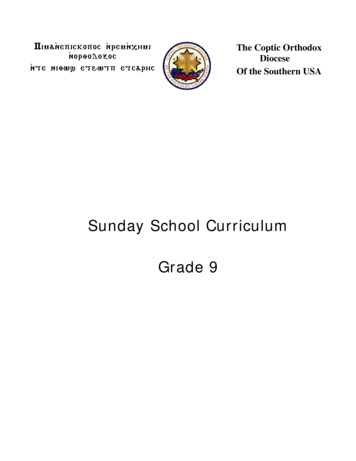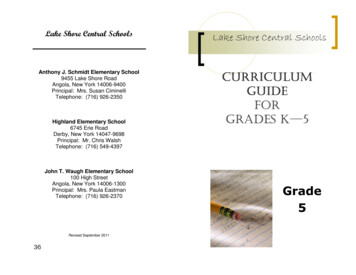
Transcription
Piman epickopoc n remn ,/min oryodoxocn te niyws ethwtp etcar/cThe Coptic OrthodoxDioceseOf the Southern USASunday School CurriculumGrade 9
Sunday School CurriculumGrade 9TABLE OF CONTENTSTABLE OF CONTENTS .IPREFACE . IVINTRODUCTION . VFILLER LESSONS.11 - School of Alexandria .22 - Jewish Feasts .73 - The Epistle to the Galatians.124 - Gambling .145 - Deborah the Judge .186 - The Holy Bible is Free from Perversion.207 - St. Philip .24LESSONS FOR THE MONTH OF SEPTEMBER .27Week 2 - Martyrs in the Cause of Chastity.28Week 3 - The Holy Cross.31Week 4 - The Ten Commandments: First: You shall have no other gods before Me .34LESSONS FOR THE MONTH OF OCTOBER .39Week 1 – The Ten Commandments Second: You Shall not Make for Yourself AnyCarved Image.40Week 2 - The Ten Commandments Third: You Shall Not Take the Name of The LordYour God in Vain .43Week 3- The Ten Commandments Fourth: Remember That You Keep Holy theSabbath Day.46Week 4 - The Ten Commandments Fifth: Honor Your Father and Your Mother.50LESSONS FOR THE MONTH OF NOVEMBER .53Week 1 - The Ten Commandments - Sixth: You Shall Not Murder .54Week 2 - The Ten Commandments - The Seventh and Tenth Commandments .57Week 3 - The Ten Commandments - The Eighth And Ninth Commandment .62Week 4 – Our Bodies Are For the Lord.66LESSONS FOR THE MONTH OF DECEMBER .71Week 1 - Different Kinds of Soil.72Week 2 - St. Luke the Apostle .76Week 3 - The Hymns of Kiahk .78Week 4 - How to Begin a New Year .83i
Sunday School CurriculumGrade 9LESSONS FOR THE MONTH OF JANUARY .87Week 1 - Glory to God in the Highest . 88Week 2 - Proverbs. 91Week 3 - The Wedding at Cana . 94Week 4 - Trinitarianism and Monotheism . 97BEGINNING OF FEBRUARY TILL JONAH’S FAST . 101LESSONS FOR JONAH’S FAST . 103Week before Fast - The Final Judgment . 104Week after Jonah’s Fast - The Book of Habakkuk . 107LESSONS FOR THE GREAT FAST PERIOD . 109Week 0 - The Old Testament . 110Week 1 - Church Fasts . 115Week 2 - Sacrifices in the Old Testament (I). 118Week 3 - Sacrifices in the Old Testament (II) . 122Week 4 - The Forgiving Father. 127Week 5 - Jesus and the Samaritan Woman . 131Week 6 - Dedication of All . 134LESSONS FOR THE PENTECOST PERIOD . 137Week 1 - The Power of Resurrection. 138Week 2 - David's sins, results and repentance . 141Week 3 – The Value of Time. 145Week 4 - Translations of The Old Testament . 148Week 5 - Translations of the New Testament. 153Week 6 - Closing the Generations Gab. 158Week 7 - How to Deal With My Brothers and Sisters? . 162THE APOSTLES’ FAST PERIOD . 165LESSONS FOR THE MONTH OF JULY . 167Week 2 - Church Vessels . 168Week 3 - Pentecost and the Birth of the Church. 171Week 4 - Ananias and Sapphira . 175LESSONS FOR THE MONTH OF AUGUST . 177Week 1 - Freedom and Discipline. 178Week 2 - The Titles of St. Mary . 181Week 3 - The Gospel of St. John . 184Week 4 - A Cloud of Witness . 188ii
Sunday School CurriculumGrade 9LESSON OF THE FIRST WEEK OF SEPTEMBER.191Week 1- I am Responsible .192iii
Sunday School CurriculumGrade 9PREFACEThe Coptic Orthodox Diocese of the Southern United States, under the auspices of HisGrace Bishop Youssef, felt the pressing need for a modified Sunday School Curriculumwhich would be better suited to address the problems and issues facing children both inAmerica and the lands of immigration. Therefore, the efforts and time of many faithfulservants have been dedicated to modify and improve the presently used English translationof the syllabus published by the Youth Services Committee of the Coptic OrthodoxPatriarchate. This has resulted in the elimination of many existing lessons from this syllabusand the substitution with new lessons that are more appropriate for our youth in Americansociety. These additional lessons give greater consideration to the differences in quality oflife, education, media influence, cultural differences and the surrounding diversity of beliefsbetween Egyptian society and that of the westWe pray that God may bless this work for the spiritual growth of our children in theimmigration countries. We also thank His Grace Bishop Youssef for his continued support,prayers and motivating guidance in this service.May God reward every servant who offered time and effort toward the completion of thisSunday School Curriculum.“ Thus Far The Lord Has Helped Us”(I Samuel 7:12)iv
Sunday School CurriculumGrade 9INTRODUCTIONThis grade 9 Sunday school curriculum has been modified by substituting 21 lessonsfrom the previous curriculum published by the Youth Service Committee of the CopticOrthodox Patriatchate with new lessons that are suitable for the youth in America. The orderof the lessons has also been changed to follow the major events in the church. This resultedin the following order assuming the starting date is the first week after the Coptic New Yearcelebration (El Nayrooz) on September 11:-3 lessons for the month of September4 lessons for each month from October through JanuaryVariable number of filler lessons for the period between the beginning ofFebruary and Jonah’s fast.2 lessons, one before and one after Jonah’s fast7 lessons during the Great Fast7 lessons for the period between Easter and the Feast of the PentecostVariable number of filler lessons between the Feast of the Pentecost and theApostles’ Feast3 lessons for the remainder of July after the Apostles’ Feast4 lessons for August1 lesson for the first week of SeptemberPlease note that filler lessons can also be used for the occasional fifth Sunday in anymonth. These filler lessons are in the beginning of the book and it is preferable that they beused in sequence for the sake of unity in all the churches.The students of grade 9 are at high emotional peak of their teenage period. Theseenergetic feelings should be directed totally towards the knowledge and love of God.Spiritual activities are very essential. It is also a very critical age where reading the Bibleand knowing its contents should be emphasized. They are probably hungering for the factsand the details. It just has to be introduced to them in an interested manner. They need goodeffort from the teacher to keep them interested and focused on the lesson. The students’interest increases when they participate in the lesson either by holding frequent discussionsin the class or by assigning research projects to one or few students for next class. Theyshould be encouraged to search and perform their own projects. The use of audiovisual aidsis still very important at this age. They also start to question many of the previous learnedfacts of faith seeking understanding. The new lessons inserted in this curriculum stressedmore Bible information, and social topics relevant to this age. It also provides multiplelessons about love and the emotional aspect, which predominates their feelings at this age.v
Sunday School CurriculumGrade 9After all, this is a preliminary modified curriculum for grade 8 that will require yourfeedback as a servant in order to continue the improvement process. Any inquiries orcomments can be forwarded to ssc@suscopts.orgMay the Holy Spirit guide every servant using this curriculumvi
Sunday School CurriculumGrade 9FILLER LESSONSThese lessons are to be used for the fifth Sunday in a month and to fill the empty weeks due tothe changing date of the Resurrection Feast.1. School of Alexandria2. Jewish Feasts3. The Epistle to the Galatians4. Gambling5. Deborah the Judge6. The Holy Bible is Free from Perversion7. St. PhilipFILLER LESSONS1
Sunday School CurriculumGrade 91 - School of AlexandriaObjective:Show the greatness of our church and how it influenced the whole world.Christian spirituality does not contradict with science.Memory Verse:“Go therefore and make disciples of all the nations” (Matthew atrology/schoolofalex/“School of Alexandria” Fr. Tadros MalatyIntroduction:Long before the establishment of Christianity in Alexandria, the city was famous for its manyschools. By far, the largest school was the “Museum,” which was founded by Pitolemy and becamethe most famous school in the East. The Museum’s library, whose directors were among the mostremarkable scholars of the world, grew to the point where it housed 700,000 volumes, making it anarsenal of knowledge that was astounding for its time.Alexandria soon became famous as a rich center of knowledge. Numerous Jewish schools werealso scattered everywhere. The geographical position of Alexandria gave a special flavor to thethought that developed in the city. Jews with their Scriptures were not the only ones who had come toAlexandria, but Babylonians had also come with their astrology, as well as Persians with theirdualism, and many others with different and often confused religions. In other words, Alexandria, thecosmopolitan city, was chosen as a home for learning, and a unique center of a brilliant intellectuallife, where Egyptian, Greek and Jewish cultures together with eastern mystic thoughts were nourishedand gave rise to a new civilization.In such an environment, there was no alternative but to establish a Christian institution to enablethe church to face the battle which was waged by these powerful schools. The school of Alexandriawas undoubtedly the earliest important institution of theological learning in Christian antiquity. It wasa college in which many other disciplines were studied from the humanities, science and mathematics;but its main discipline was religion.Lesson Outlines:I. The Christian SchoolSt. Jerome records that the Christian School of Alexandria was founded by St. Mark himself. Hewas inspired by the Holy Spirit to establish it to teach Christianity, as this was the only way to give thenew religion a solid foundation in the city.The School became the oldest center for sacred sciences in the history of Christianity. In it, the firstsystem of Christian theology was formed and the allegorical method of biblical exegesis was devised.2FILLER LESSONS
Sunday School CurriculumGrade 9II. Its DevelopmentWe are not, of course, to think of school buildings in any modern sense; we are not even to think ofchurch buildings. Instruction was in the teacher’s private house.This Christian School started as a Catechetical School, where candidates were admitted to learn theChristian faith and some Biblical studies to qualify for baptism. Admittance was open to all peopleregardless of culture, age or background.III. Influence on the churchBy the second century it became quite influential on church life as can be seen from the following:1. It was able to satisfy the thirst of the Alexandrian Christians for religious knowledge, encouragehigher studies and create research work in a variety of fields. G.L. Prestige gives us a picture aboutthe students of Origen, the dean of the School, saying: “So their education was completed. Noinquiry was closed to them; no knowledge was withheld from them. They had the chance to studyevery branch of learning, Greek or foreign, spiritual or sociological, human or divine. We werepermitted with entire freedom to compass the whole round world of knowledge and investigate it,to satisfy ourselves with every variety of teaching and to enjoy the sweets of intellect.”2. It gave birth to numerous spiritual and well-known church leaders along the years. Many of themdeserved to sit on the throne of St. Mark.3. Through its missionary zeal, it was able to win many souls to Christianity from Egypt and abroad.4. In a true ecumenical spirit, it attracted students from other nations, many of whom became leadersand bishops in their own churches.5. It established a common awareness of the importance of education as a basic element in religiousstructure.6. It offered the world the first systematic theological studies.7. It used philosophy as a weapon in dealing with pagan philosophers, and thus beating them by theirown game.8. Although the School of Alexandria was a church school, and had its spiritual and educationaleffect on the clergy and laymen and many of its deans were ordained Popes, nevertheless it did notinterfere in church affairs (organization).IV. Its ProgramIt would have been a grave error to have confined the School’s activities to theology. Its teachingwas encyclopedic; first presenting the whole series of profane sciences, and then rising to moral andreligious philosophy, and finally to Christian theology, as set forth in the form of commentaries on thesacred books. This encyclopedic conception of teaching was an Alexandrian tradition, for it was alsofound in Alexandrian pagan and Jewish schools.Three courses were available:1. A special course for non-Christians, which introduced candidates to principles of Christianity.2. A course on Christian morals.3. An advanced course on divine wisdom and sufficient knowledge for the spiritual Christian.Worship went side by side with study in the School. Teachers and their students practiced prayer,fasting and diverse ways of asceticism. In addition to continence in food and drink, they were alsocontinent in earthly possessions. In purity and integrity their lives were exemplary. Celibacy was arecommended ideal, and was observed by many.FILLER LESSONS3
Sunday School CurriculumGrade 9V. Famous Alexandrian School DeansA quick glimpse of the names that headed the Christian School of Alexandria provides selfevidence of the history of the school and its rank among similar institutions. Among these areAthenagoras, Pantaenus, Clement, Origen, Heraclas, Alexander, Dionysius, Theognostes, Peter,Macarius, Didymus the Blind, as well as Athanasius the Apostolic, Cyril of Alexandria, Dioscorus,etc.St. Mark the apostle, in his last days, appointed Yostius as the new dean of the School. The newdean was the contemporary of four Patriarchs who succeeded St. Mark, until he was ordainedPatriarch for Alexandria in the year 121 AD.The western historians do not mention Yostius, Eumenius, and Marcianius, the first three deans ofthe School of Alexandria, for the following reasons:1. Since the pastoral care of the Fathers kept them quite busy, especially with non-Christians, theyeither had little opportunity to write or their writings were lost.2. The learned philosopher Athenagoras influenced the School greatly due to his philosophicalability; which brightened his star over his predecessors. Hence the beginning of the School wasrelated to him, especially that his writings were universally interchanged from the first centuryeven though his name as a writer was not mentioned as we shall see. Many historians believeAthenagoras was the first principal of the School.A. AthenagorasHe is a philosopher holding an academic position in the Museum at Alexandria, and is regarded as aleader in paganism. He was attracted to search in Christianity for mistakes and corruption just as otherPlatonic philosophers.He was anxious to write against Christianity. He read the Holy Scriptures in order to aim his shaftsof criticism more accurately, but he was so powerfully seized by the Holy Spirit that he became adefender of the faith he was attacking. Not only was he converted to Christianity (c. 176), but healso became one of the most famous deans of the Christian Theological School.He was called the Apologist. This name was especially given to Christian writers who firstaddressed themselves to the task of making a reasoned defense and recommendation of their faith tooutsiders.B. PantaenusBesides being a great teacher, he was credited as one of those who adopted the Greek alphabet inthe Coptic script. His works of exegesis have been lost. In the course of his service, PatriarchDemetrius I elected him for the Christian mission to India.C. ClementTitus Flavius Clement was the father of the Christian philosophy of Alexandria, and was wellversed in the Holy Scriptures. He was born around the year 150 A.D.His parents were not Christians. Clement was a converted person, not a birthright Christian.Nothing is known about the date, circumstances or the motives of his conversion. He was religiousminded. He was seeking God. But God had to satisfy him religiously, intellectually, and morally. Hefound that the God of the Christians could do this. The gods of the Greeks seemed to him empty ofpower, philosophically inept, and morally corrupt and corrupting. So, reluctantly, gradually,thoughtfully, he rejected them, and found among the Christians the God he was seeking. It is knownthat he made extensive travels to Southern Italy, Syria, and Palestine. His purpose is to seek4FILLER LESSONS
Sunday School CurriculumGrade 9instruction from the most famous Christian teachers. He was searching unceasingly for God. At theend of his journey, he reached Alexandria where St. Pantaenus’ lectures attracted him to the extentthat he settled there and made this city his second home.He became the disciple, and assistant of St. Pantaenus. He was ordained a priest in Alexandria,discharged his catechetical duties with great distinction, and followed St. Pantaenus as head of theSchool before 190 A.D. Among his disciples were Origen and Alexander, bishop of Jerusalem. It isclear, alike from his general attitude and from specific references, that he was a shepherd of souls aswell as a formal teacher, a minister to the needs of others.Clement wrote abundantly although much of his work was lost. His chief works are Protrepticus(An Exhortation to the Greek), The Pedagogus (on Christian life and ethics), and his Stromaties(miscellaneous studies) in which he compiled treatises of various characters. He was regarded as oneof the leaders of Christian liberalism, as he attempted to reconcile Greek culture and Christianity.D. OrigenSt. Didymus the Blind, the head of the School of Alexandria in the latter half of the fourth century,described Origen as “the greatest teacher in the Church after the Apostles.”Origen (c. 185 AD - c. 254 AD) followed Clement about the year 215. He was Clement’s mostbrilliant student. As a young man, he was extremely ascetic by nature. He carried the word of theGospel (Matt. 19:12) literally and to the extent of mutilating himself. This fact of becoming a eunuchcontributed of his future troubles with patriarch Demetrius I.Origen devoted himself with the utmost ardor not only in studying and teaching the Holy Scripture,but also giving his life as an example of evangelical life. His disciple St. Gregory the Wonder-makersays that “he stimulated us by the deeds he did more than by the doctrines he taught.”His wandering extended from Arabia and Syria to Greece and Rome. As a Biblical scholar andphilosopher, his creativity was massive. His amazing critical edition of the Old Testament, theHexapla, combined in six parallel columns all the available text in both Greek and Hebrew scripts:1. The Septuagint, the Greek translation of the Old Testament which the church employed.2. Aquila, who lived at the beginning of the second century, made a new translation into Greek, aword-for-word translation. His translation was very literal, preserving Hebrew word order andidiomatic turns of phrase.3. A second Jewish proselyte, living at the same period, Symmachus, produced a translation in moreacceptable Greek. His work was more in the nature of a revision of the Septuagint.4. Another Greek translation, that of Theodotion.5. An anonymous version he acquired at Nicopolis during a visit to Greece.6. Another anonymous version, this was only partial, had been discovered in the neighborhood ofJericho in a jar that contained a number of Hebrew and Greek manuscripts.His monumental exegetical commentaries, the Scholia, were partly put into Latin by Rufinus. In therealm of theology, his most important work was the De Pricipiis, in which he systematized the wholeof the Christian doctrine. In a treatise called Contra Celsum, Origen defended Christianity fromattacks by the second-century pagan philosopher Celsus. He wrote a number of ascetic works, two ofwhich have come down to us: The Exhortation to Martyrdom and On Prayer.During the Decian persecution of 250, the great master suffered tremendously; he was imprisonedand tortured. Though he regained his freedom, his health began to decline, and he died at Tyre in 255.FILLER LESSONS5
Sunday School CurriculumGrade 9E. HeraclasOrigen’s immediate successor was Heraclas, his former student and assistant who later followedDemetrius as Patriarch from 230-246 AD. It is said that when he increased the number of localbishops to 20, the presbyters decided to distinguish him from the rest of the bishops by calling him“Papa.” Thus, he was the first to bear the title of Pope, long before it was known to Rome.F. DionysiusThe next head of the School, another famous student of Origen, was Dionysius of Alexandria, latersurnamed the Great. He occupied that post until he became patriarch (246-264 AD).G. DidymusAt a later date, St. Athanasius entrusted Didymus the Blind (313-398 AD) with the headship of theschool. Among his students were St. Gregory of Nazianzen, St. Jerome and the historian Rufinus. Hecared for the welfare of the blind, as he had been blind since the age of four, by promoting a system ofwriting for them. In this method, he anticipated Brailled by fifteen centuries.VI. Its DeclineAfter Didymus, we entered the obscure period in the history of the school. After the first split of theChurch which happened as a result of the Council of Chalcedon in 451 AD, the emperors ofConstantinople closed the School in their persecution against the Copts. In 1893 AD, Pope Kyrillos Vinaugurated the new seminary in Cairo. Beside this main one, Pope Shenouda III has establishedanother six seminaries in Alexandria, Tanta, Menoufeia, Menia, Mouharrak Monastery and Beliana, inaddition to two seminaries in the USA, and one in Australia.Conclusion:The school of Alexandria is a strong historic indicator of the care of the Orthodox Church toreligion education and theology on high standards. It is a cornerstone in many of the fathers’sayings and our understanding of the Bible.Applications:AssiGenesis one of the students to do a project about the School of Alexandria and present it tothe class.6FILLER LESSONS
Sunday School CurriculumGrade 92 - Jewish FeastsObjective:To be familiar with some of the traditions and feasts of the Jews to help better understandmany of the bible events.Memory Verse:“So let no one judge you in food or in drink, or regarding a festival or a new moon or Sabbaths,which are a shadow of things to come, but the substance is of Christ” (Colossians 2:16, 17)References:“Feasts” Fr. Marcorious Anba Bishoy“Our Christ Above Time” Late Bishop Youannes of GharbiaIntroduction:The Old Testament is full of different feasts and occasions that the Jews used to keepconservatively. Many of these feasts were religious and related to instructions given to them from Godthrough the prophets. Understanding some of these feasts sheds a light on the Old Testament eventsand increases our understanding of the Bible.Lesson Outlines:I. Feast of the TrumpetsThis was on the first day of the seventh month of the religious calendar which was thebeginning of the civil calendar.“Then the Lord spoke to Moses, saying, “Speak to the children of Israel, saying: In the seventhmonth, on the first day of the month, you shall have a Sabbath-rest, a memorial of blowing oftrumpets, a holy convocation. You shall do no customary work on it; and you shall offer anoffering made by fire to the Lord” (Leviticus 23:23-25).The priest would blow the trumpets from sunset of the evening before the feast till sunrise,thirty times. It was allowed for the people also to blow the trumpets.As the trumpet gathered the people in front of God, “And He will send His angels with a greatsound of a trumpet, and they will gather together His elect from the four winds, from one endof heaven to the other” (Matthew 24:31).The trumpets were a symbol of the trumpets on the last day, so this feast is a symbol of thegeneral resurrection.II. Feast of Atonement (YOM KIPPUR) (Leviticus 16, 23)This was celebrated on the tenth day of the seventh month of the religious calendar.According to Jewish tradition and the Talmud, Yom Kippur has been one of the great JewishFeasts celebrated annually. In ancient times the people would joyfully dress in white,anticipating their purification from sin.It was only once a year, on this day, that would allow the High Priest to enter behind the veilinto the Holy of Holies. And this could be done only after sacrificial blood had been shed toFILLER LESSONS7
Sunday School CurriculumGrade 9cover his own transgressions as well as those of the Jewish nation. In the Holy of Holies, hecould then approach the mercy seat and receive assurance that God had sanctified the sacrificefor sin.
Sunday School Curriculum Grade 9 PREFACE The Coptic Orthodox Diocese of the Southern United States, under the auspices of His Grace Bishop Youssef, felt the pressing need for a modified Sunday School Curriculum which would be better suited to address the problems and issues facing children both in America and the lands of immigration.










